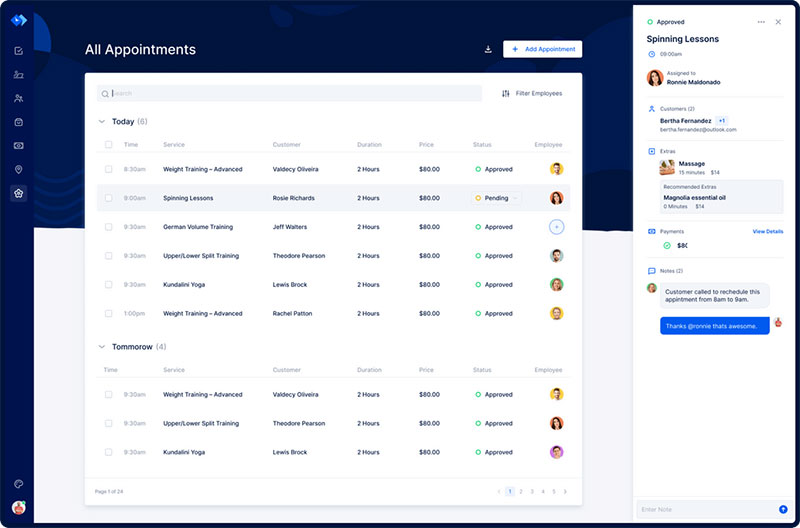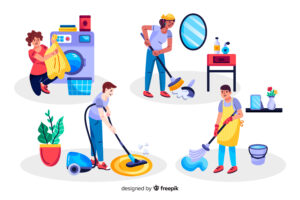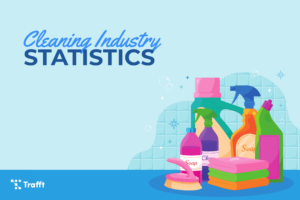When you’re a kid, you often don’t realize what goes into cleaning a house. Rub the counter with a wet rag, wash the floor with soapy water, put away all the toys, and be done! Sadly, when you grow up you start to realize how much more goes into keeping your home clean.
You may have already found some tips and tricks that help you clean, but could you find more? What more cleaning tips can you learn?
To help you with future cleaning, this article contains some important house-cleaning statistics.
General House Cleaning Statistics
The real estate company Lombardo Homes released a study saying that 1,070 respondents between the ages of 18 to 79 say their most hated chore is cleaning/sanitizing bathrooms. They can increase that number to 1,071 because I don’t like it much either.
The cleaning habits and cleaning industry statistics of 2019 say that windows are the main priority for 49% of people during spring cleaning.
According to a recent survey, 46% of respondents do their own cleaning. About 30% of Gen Z respondents reported that they rely on their parents (or another close relative) to clean their homes. Sadly, very few respondents, only 3%, use cleaning services for their homes.
Nearly 99% of all carpet stains can be removed completely if they are cleaned in the next couple of days, but don’t let the carpet cleaning industry know.
According to a Cleaning Institute Survey, most individuals spend 2 to 4 hours cleaning their houses every week.
Recent EPA studies regarding human exposure to air pollutants have shown that indoor levels of pollutants are on average two to five times higher than outdoor levels, and at its worst more than 100 times higher.
Research has shown that nearly 60% of people close the doors in their homes to hide dirt, dust, and clutter from guests.
An average of 20% of men have stated that they never clean their homes thoroughly.
An average of nearly 31% of couples argue about housework a minimum of once a week.
The average person deep cleans their home five times a month and cleans their home normally seven times a month.
The average person will clean for 12,896 hours in their lifetime. This translates to 1.5 years, 77 weeks, or, in other words, a very long time.
According to a survey, nearly 1 in 4 respondents agree that leaving dirty dishes out is the worst cleaning offense in a relationship. Wearing stained clothing and never offering to help clean were both also among the top three. In fact, about 36% of respondents say they would rather turn down a promotion than live with someone who wears stained clothing.
A recent ACI survey conducted by Wakefield Research found that nearly a quarter of respondents’ favorite cleaning task is laundry. Cleaning countertops was second (21%), Vacuuming was third (21%), and doing dishes was trailing in fourth (17%).
Another ACI study conducted by Wakefield Research showed that nearly 47% of people don’t remember the last time they cleaned their oven. After that, 41% can’t remember the last time they cleaned their refrigerator, 23% their bed linens, and 16% their guest bathroom toilet. Lastly, nearly 20% have never cleaned their washing machines.
The main qualities spring cleaners look for in cleaning products are effectiveness, cost, and multipurpose use. After the entire spring cleaning process, most people (36%) feel accomplished, 29% are satisfied, 18% are safe, and 18% are happy.
A recent (2018) survey says that 34% of people are concerned whether they clean enough, while 31% wonder whether they are cleaning correctly.
Fifty-one percent of women do housework daily.
Although most people take six days to spring clean, some get it done faster. Twenty-nine percent of people finish in one to two days, while 31% finish in three to four days.
Another recent survey found that 42% of respondents put clothes, closets, and drawers as their main cleaning priority. Another 25% said that cleaning floors are their priority instead.
If you have been looking for a reason to clean, here’s one. It’s been proven that a clean home improves focus, productivity, and mental health.
Cleaning can even help you lose weight! Although the exact number of calories you lose will depend on your weight and the intensity of the cleaning activity, the statistics show that generally, a person who weighs 180 pounds (81.65 kg) will burn 200 calories during an hour of light sweeping, 215 calories during an hour of mopping, and 300 calories during an hour of scrubbing floors on their hands and knees.
Studies have shown that you should clean your sheets every week, disinfect your sinks every day, vacuum rugs every week or two, and clean the bathroom weekly, at least. Although you can survive without doing so, these are helpful habits to develop.
Industry House Cleaning Statistics
Did you know? The global cleaning product market was worth $163,981,000 in 2019. It is expected to grow to $312,493,000 by 2027.
Recently, household cleaning products have been globally surging in demand. This has been largely due to an increased global concern with health, cleanliness, and hygiene.
The hourly prices for house cleaning services in the US have grown recently, and are now costing between $55 and $65 an hour for deep cleaning. For reference, the average price pre-covid was between $25 to $30.
It is expected that nearly 80% of multi-income households will employ a cleaning business for their homes during the next few years. This is according to the US Department of Commerce.
Residential cleaning industry statistics show that the median hourly wage for a residential cleaner is $13.84, or $28,780 yearly.
The global commercial cleaning market could reach $468.2 billion in revenue by 2027, according to commercial cleaning industry trends.
Also, the residential cleaning market is expected to reach $40.38 billion by 2025.
The cleaning services industry has been growing by 6.6% yearly since 2011.
The janitorial services industry will increase in revenue by about $2 billion by 2023 in the U.S.
The cleaning industry revenue also grew by 14% in 2021.
Ten percent of all cleaning jobs were contracted instead of being one-off work in 2021.
The cost to employ building cleaners rose by 9.4% in 2021.
According to Allied Market Research, North America has the largest cleaning services market. On the other hand, the Asia-Pacific market was expected to have the fastest growth between 2016 and 2022.
The cleaning industry has many opportunities. Studies showed that the cleaning industry would earn over $46 billion in 2020, and grow 10% by 2026. There are currently more than 1.7 million people employed in the cleaning industry, and yet, it is projected to grow 6% yearly. This is in part due to the recent popularity of the industry, especially within single-person households, which make up 27% of America.
Get more bookings with the right tool for the job
Staying organized has never been easier.
You can now manage your business and grow your brand with a single, powerful software that keeps all of your appointments in line, your clients organized and your business booming.
Trafft is the perfect cleaning business software for business owners who need to streamline their booking experience both for their staff and their clients.
Trafft handles everything for you, even sending automated email or SMS reminders to your clients. No-shows? Not anymore!
The Trafft booking software adapts to different industries for a blissful online booking experience and employee management.
Want to know more? Check out Trafft’s awesome features to see what you are missing.
Cleaning Facts about Germs
The National Sanitation Foundation has found that your kitchen is full of germs, but not only your kitchen. They found that the kitchen has more bacteria and fecal contamination than anywhere in the home. The dirtiest items within are the cutting boards, countertops, sink, refrigerator, and coffee maker.
Studies have shown that germs are very resilient, and can survive up to three days on wet surfaces, and up to 24 hours on dry surfaces. Salmonella, for example, can survive a whole day in the kitchen sink, regardless of the temperature.
It’s no surprise then that smartphones can easily hold E. coli and Streptococcus bugs that they pick up along the way. Since you bring it everywhere, phones can easily be more infectious than a toilet seat. This is why many disease experts, like Philip Tierno, suggest wiping it at the end of every day.
A single square meter of carpet can accumulate almost one kilogram of dirt.
A single bacterium can multiply into eight million in under 24 hours!
Studies have shown that nearly 10,000 dust mites live in the average bed. Dust mites often cause different forms of allergies or asthma.
Other studies have shown that the kitchen sponge can host 362 different species of bacteria, with 45 billion of them per square centimeter. Although this can be a scary thought, there is hope. To try to minimize this process, replace your sponge often, like every couple of weeks, and clean it every few days. You can clean your sponges by wetting them and placing them in the microwave for 60 seconds. Another good way to minimize bacteria is by keeping your sponges away from raw meat.
The best and most cost-effective way to fight germs is by washing your hands. No matter how much cleaning you do in your home, if you’re not washing your hands regularly, you are likely to get sick. To illustrate this point, the CDC stated that one million deaths would be avoided every year by routine handwashing.
Humans are not the only species that live in houses. Studies have shown that approximately 7,000 different species of bacteria float around the average house, and that’s only in dust particles.
What Have You Learned from These House Cleaning Statistics?
Cleaning habits can be just as personal as the home in which you live. Everyone is different, and everyone will clean their home differently.
Some may choose to clean their home more thoroughly, armed with the tips in this article. Others may choose to hire a cleaning business after seeing the recent surge in popularity they have had. No matter how you choose to clean your home, remember that it’s your home to clean. This means that you can clean however you want to clean. The choice is yours, but remember to stay safe!
Looking for More Cleaning Business Resources?
For more tips and tricks on how to start, manage, and grow your cleaning business, check out the following articles:
- How to Start a Home Cleaning Business
- How Much to Charge for House Cleaning
- How Profitable Is a Cleaning Business?
- Cleaning Industry Statistics in 2024
- Cleaning Service Business Names to Start from for Your Company
- How to Start a Cleaning Business & Be Successful




